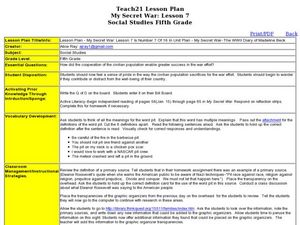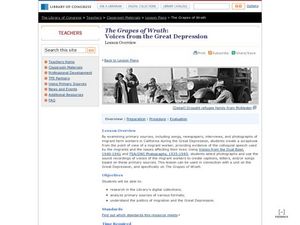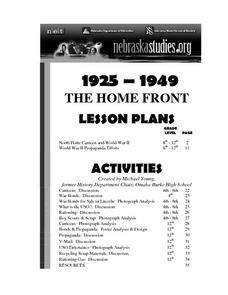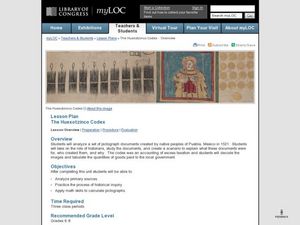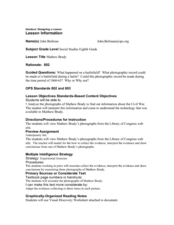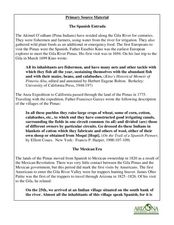Primary and Secondary Sources Teacher Resources
Hi, What do you want to do?
Find Primary and Secondary Sources lesson plans and worksheets
Showing 7,207 resources
Curated OER
My Secret War: Lesson 7
Fifth graders discuss the cooperation of the civilian population during World War II. In this social studies lesson, 5th graders read My Secret War and complete reflection strips over the reading. Students discuss primary sources.
Curated OER
Indian Boarding Schools
Middle schoolers research government-run American Indian boarding schools. In this American Indian history lesson, students analyze primary documents to develop an understanding of the forced acculturation of American Indians through...
Curated OER
The Grapes of Wrath: Voices from the Great Depression
Students research the Great Depression. In this Great Depression lesson, students analyze primary sources to develop an understanding of the plight of migrant farm workers during the Great Depression as they read Steinbeck's The...
Curated OER
Dispute Over Slavery in Kansas Territory
Students analyze primary sources on slavery from Kansas Territory. For this Civil War lesson, students evaluate the antislavery and pro-slavery arguments and summarize key points. Students write a persuasive paper from the antislavery...
Curated OER
Demosthenes Warns of Danger
For this ancient Greece worksheet, students read the primary source "Demosthenes Warns of Danger," and then respond to 6 short answer questions based on the provided source.
Curated OER
The Garber Family Letters: Recreating 19th-Century Family
Students interpret primary sources and recreate the story of the Garber family.
Curated OER
North Platte Canteen and World War II
Students employ primary resources to investigate the rise and decline of a canteen in World War II. The significance of volunteerism and the use of the railroad for troop transportation are examined.
Curated OER
World War II
Students analyze primary sources (photographs) for evidence of American military technology during WWII. They debate the use of the Atomic Bomb. Students view the Rosenthal image. They discuss the image in detail.
Curated OER
Lesson PlanThe Huexotzinco Codex
Middle schoolers examine primary sources that include pictographs from Puebla, Mexico. In this Huexotzinco Codex lesson, students perform historical analysis as they investigate the codex as they make inferences and draw conclusions...
Curated OER
Language and Runaway Slave Ads
Students interpret historical evidence presented in primary resources. In this fugitive slave instructional activity, students research and analyze fugitive slave advertisements from Virginia newspapers.
Curated OER
Mathew Brady: Civil War
Eighth graders interpret historical evidence presented in primary resources. For this Civil War lesson, students analyze photographs taken by Mathew Brady.
Curated OER
Interpreting Political Cartoons – Vietnam Era
Eleventh graders explore opinions regarding U.S. involvement in Vietnam. In this primary source analysis lesson, 11th graders analyze political cartoons related to the Vietnam War and then respond to the provided discussion questions.
Curated OER
Worksheet for Analysis of a Map
For this primary source analysis worksheet, students respond to 6 short answer questions that require them to analyze the maps of their choice.
Curated OER
Worksheet for Analysis of a Motion Picture
In this primary source analysis worksheet, students respond to 14 short answer questions that require them to analyze the motion picture of their choice.
Curated OER
A State Divided - Maryland in the Civil War Era
Students use primary sources to see how Maryland was a divided state during the time leading up to the Civil War. In this Civil War lesson plan, students go over vocabulary, and look at maps that show the division of opinions of people...
Curated OER
The Spanish Entrada
In this Arizona history worksheet, high schoolers read a 5 page selection that includes primary sources about time periods in the state's history. Students then respond to 5 short answer questions based on the selection.
Curated OER
The American West: Images of Its People
Learners interpret historical evidence presented in primary resources. In this American West lesson, students examine photographs that reveal the cultural components of the West and then write narratives regarding the photographs.
University of North Carolina
History
The past helps to inform the present and the future—that's why the study of history is so important. The handout describes what historians do and why their jobs are meaningful. Readers learn about what to expect in a college-level...
Roy Rosenzweig Center for History and New Media
Immigrant Discrimination
For a class learning about Chinese and Irish immigration in America, here's a great starting lesson plan. It has your critical thinkers examining song lyrics, the Chinese Exclusion Act of 1882, and a political cartoon, and finally...
American Battle Monuments Commission
World War II: A Visual History
Explore the enormity of World War II, including its causes, prominent battles, and historical figures, with an interactive map and timeline. Divided into each year from 1939 to 1945, as well as sections pre- and post-war, the resource...
TED-Ed
The Pharaoh That Wouldn't Be Forgotten
Why, 20 years after the death of Egyptian pharaoh Queen Hatshepsut, did people attempt to erase her memory from Egyptian history? Gain insight into ancient Egyptian culture and how a female monarch was viewed with this...
Curated OER
Introduction to Primary and Secondary Sources
Fourth graders are introduced to primary and secondary sources. Using examples of each type of source, they work together to identify which are primary and which are secondary sources. They end the lesson by reviewing the...
Curated OER
Having Fun with Primary Sources
Students analyze primary sources to determine the effects of the Great Depression on American society. They evaluate how government expanded during this time period because of New Deal legislation.
Curated OER
Sources of Information
For this sources of information worksheet, students respond to 7 fill in the blank questions regarding primary and secondary sources.
